Past News
Press Releases
Press Releases

2025
- October - Integrating Business Phone Systems to Microsoft Teams to Increase Customer Collaboration Productivity and Profitability
- September - Securing VoIP Phone Systems with Latest Cybersecurity Solution
- August - Enhancing Customer Experience by Investing in AI Automation
- July - Deploying Advanced Managed Browser Security to Protect Clients from Human Error and Online Threats
- June - The Windows 10 Deadline is Approaching Fast
- May - Leveraging Latest Mobile Enablement Technology to Enhance Hybrid Workforce Productivity
- April - Protecting Customers with the Best First Line of Defense Against Cyber Attacks
- March - Mastering Execution - United Systems Inc Leadership Invited to Attend 24th Annual TAG Convention
- February - Taking the Lead in Transitioning Customers IT Networks to Microsoft Azure
- January - Accelerating Customer Profitability and Competitive Advantage Through the Utilization of Technology
2024
- December - United Systems Certified as a Microsoft Solutions Partner Ranking Among the Top 5 Percent of Providers
- November - Delivering Strategic Business Reviews to Help Organizations Capitalize on Todays Technology
- October - Informing Business Owners of New Section 179 Tax Deduction Limits for 2024
- September - Safeguarding Customer Networks by Exposing and Eliminating Website Vulnerabilities
- August - Leveraging New Vulnerability Management Technology to Secure Customer Networks
- July - United Systems Offers Business Critical VoIP Integrations to Maximize Customer Profitability and Productivity
- June - Revolutionary Network Data Discovery and Cyber Risk Management Solution for Businesses
- May - United Systems Launches Program to Backup Microsoft 365 for Local Businesses
- April - United Systems, Inc. Leverages Latest Technology to Optimize Customers' Networks
- March - United Systems Invited to Attend Top Technology Event of the Year
- February - United Systems Improves Mobile Work Experience for Small to Mid-Sized Businesses
- January - Helping Small to Mid-Sized Businesses Leverage the Power of Microsoft Teams to Collaborate Faster and More Effectively
2023
- December - While Building a New Facility Dont Forget About the Pre-Planning Phase
- November - United Systems, Inc. Advises Businesses to Leverage Section 179 Deduction
- October - United Systems Enhances Their Customers Marketing Campaigns Through On-Hold Messaging
- September - New Artificial Intelligence Protects Companies From the Latest AI Phishing Attacks
- August - Presence Management - The Greatest Form of Communication
- July - United Systems Utilizes Latest AI Knowledge Management to Outpace IT Competitors
- June - United Systems Drives Profitability and Performance with Integrated Contact Center Technology
- May - United Systems Launches New Managed Data Backup Services
- April - Implementing Data Retention Policies for Local Businesses
- March - Launching Managed Detection and Response to Thwart Cyberattacks
- February - United Systems Invited to Attend 22nd Annual TAG Convention
- January - United Systems Offers SD-WAN-as-a-Service to SMBs
2022
- December - Leveraging Powerful Artificial Intelligence Anti-Phishing Technology to Keep Email Inboxes Safe
- November - Urging Business Owners to Take Advantage of Section 179 Deduction
- October - Leveraging Latest Mobile Enablement Technology to Enhance Hybrid Workforce Productivity
- September - How to Know If Your Network Is Ready to Make the Transition to VoIP
- August - Want to Streamline Your Business and Provide a Better Experience - Using the Right Communication Technology Will Help You Do Just That
- July - Integrating Business Phone Systems to Microsoft Teams
- June - 5 Key Factors to Understand When Selecting a Cloud Voice Provider
- May - Presence Management The Greatest Form of Communication
- April - United Systems Announces Full-Service Cloud Voice Program
- March - United Systems Selected to Share Their Expertise at Top IT Event
- February - Don't Let Your Competitor Beat You to Cloud Voice
- January - How to Replace Discontinued Phone Systems with Cloud Technology
2021
- December - Preparing Businesses to Seamlessly Adopt Windows 11
- November - Alerting Customers About Section 179 Tax Advantage Deadline
- October - United Systems Invited to Speak at TAG Annual Convention
- September - SaaS Alerting Technology to Manage Common Business Applications
- August - How to Replace Manufactured Discontinued Phone Systems
- July - Attackers Have Successfully Hit the Nation’s Largest Corporations
- June - Cloud Voice Makes Small Companies Look Like Big Business
- May - Healthcare Institutions Struggling to Keep Patient Data Safe
- April - Malware is Running Rampant - Learn the 3 Moves to Stop It
- March - How Artificial Intelligence Will Impact Small to Mid-Sized Businesses
- February - Helping Businesses Shift from Survival Mode to Strategic Growth Mode
- January - Leveraging Clearfly for Mission Critical Communications
2020
- December - Protecting SMBs from Exponential Growth in Cybercrime
- November - COVID-19 Accelerates Azure Adoption Among Customers
- October - Helping Businesses Deduct Up to $1M on Qualifyng Equipment Expenses
- September - Forecasting What the Future of Work-From-Home
- August - Providing Customers With a Technology Plan for Continued Operations
- July - Helping Companies Transition From Old Phone Systems that Hindered Remote Work
- June - Thermal Cameras and Scanners to Keep Employees and Customers Safe
- May - Providing Innovative Home Office Cybersecurity for Remote Workers
- April - Empowering Companies to Combat COVID-19
- March - Helping Companies Transition to Remote Workforce
- February - Leveraging Microsoft Azure to Take Customers Into the Cloud Cost Effectively
- January - Leverage the Power of Microsoft Teams to Collaborate More Effectively
2019
- December - Top 3 Business Collaboration Tools in 2020
- November - Monitoring the Dark Web to Keep Customer Information Safe
- October - United Systems Launches Secure WiFi-as-a-Service to Protect Customers from Cyber Attacks
- September - Trade Oversized Lease Agreements for New Technology
- August - Announcing Full-Service Cloud Voice Program
- July - Educating Customers on How to Upgrade to Cloud Technology
- June - Alerting Businesses About Robocall Scams
- May - Moving to the Cloud with Azure
- April - United Systems Offers SD-WAN-as-a-Service
- March - Educating Businesses on Surveillance and Security Breakthrough
- February - United Systems, Inc. Shares Expertise at Annual Convention 2019
- January - Protecting SMBs from Windows 7 End of Life
2018
- December - Protecting SMBs From DNS Attacks
- November - Leveraging Inspeed Networks to Provide Quality Services
- October - Helping SMBs Use IRC Section 179
- September - Leveraging Inspeed Networks to Provide Quality Services
- August - Best Practices for Thwarting Phishing Attacks
- July - New Cybersecurity Regulations on Horizon for Corporate America
- May - United Systems' Technology Thwarts Cryptojacking
- April - United Systems Becomes Virtual CIO
- February - United Systems Selected to Attend 18th Annual TAG Convention
- January - Heightening Cybersecurity with ID Agent
2017
- December - State of the Union for Technology
- November - Alerting Businesses About PCI Compliance
- September - Cloud Workspace Disasters
- August - United Cybersecurity Certification
- July - The Importance of a 4G Backup
- June - Enhancing Customer Network Performance with New Technology
- May - Cybersecurity Helps Local Businesses Protect Against Global Attacks
- March - Helping Businesses Reduce Overhead and Boost Productivity
- February - Invitation To Technology Assurance Group 17th Annual Convention
- January - Informing Businesses of VoIP Audio Issues
2016
- December - Leveraging Cybersecurity Tools to Protect Customers
- November - Educating Private Healthcare Practices on Handling HIPAA Audits
- October - Announcing Strategic Partnership with CloudJumper
- September - Helping Businesses Deploy and Harness the Power of Gigabit Networks
- August - Offering Innovative Cloud Disaster Recovery Solutions
- July - Educating Customers on Password Protection Policies
- June - Leveraging the Power of the Cloud
- May - Reporting on Growth of Millennials in the Workforce
- April - Educating Customers on Ransomware
- March - Educating Customers on the Power of Microsoft Office 365
- February - United Systems to Attend Leadership Conference
- January - How IT Outsourcing Has Changed Roles
FORT MADISON DAILY DEMOCRAT PUBLISHES ON APRIL 19, 2005
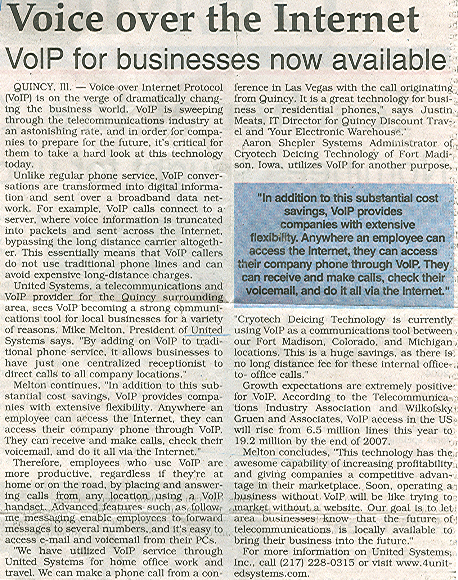
United Systems Develops Customer Advocate Department to Provide Valued Customers with an Even Higher Level of Service and Satisfaction
Customer Advocates to Help Businesses Take Advantage of Leading Technology to Increase Profitability and Give Them a Competitive Advantage
QUINCY, IL - April 2005 - United Systems, Inc., an industry leader in telecommunications, announced today that the company has developed a new department to provide current and prospective customers with an even higher level of service and satisfaction. The Customer Advocate Department will help businesses of all sizes take advantage of leading communications technology to increase profitability, enhance productivity, and give them a competitive advantage in their marketplace.
"We conducted a thorough needs analysis of our vast customer base and found that companies were interested in learning more about the latest developments in communications, find creative ways to reduce costs, and obtain a better understanding of how to efficiently utilize technology to grow their organizations. However, these same companies didn't have the means, resources, or expertise to stay at the forefront of advancements in technology," said Mike Melton, President of United Systems. "This attitude is very different than recent years when executives were only concerned with plugging in the equipment and letting them run on their own. Technology is changing so rapidly that in order to remain competitive one has to adapt and maximize it to the fullest extent or they may not be around tomorrow."
The mission of United Systems' Customer Advocate Department is to engage the telecommunication company's customers and proactively make them aware of technologies that they haven't currently adopted which could greatly benefit their business. Some examples of these technologies include Voice over Internet (VoIP), call accounting, web and audio conferencing, GPS tracking systems for company vehicles, voice recognition, and digital surveillance systems. Through its strategic partnerships with leading industry providers like BandTel, Ultimate Software, IPx Connect, Network Car and MG Security Systems, United Systems can easily coordinate and implement numerous solutions, which in most cases will have an immediate impact on the performance of any company. Each Customer Advocate will communicate critical information via online technology seminars, ongoing email newsletters, and one-to-one communication.
"We strongly believe that our Customer Advocate Department will keep our customers educated on an ever changing technological environment and enhance the performance of their business," added Mr. Melton. "Our objective is to assist our customers in bridging the gap to technology and design a game plan to successfully implement it within their companies. Our success depends on those businesses we serve and I feel it is United Systems' duty, as their strategic telecommunications partner, to provide an avenue that will help them experience significant success."
VoIP the Future of Biz Communication?
Published: February 15, 2005
Over the coming years, businesses will increasingly turn to IP telephony for their communication needs.
In-Stat reports that over 30% of businesses of all sizes in the US are interested in Internet protocol (IP) telephony and plan to adopt such solutions this year. Currently, 10% of the installed base of voice lines in the enterprise market is using IP telephony.
In-Stat explains that the key to usage growth is if vendors address the needs of every organization no matter what size. Kneko Burney, Chief Market Strategist for In-Stat, says, "...the successful vendors will be those that offer customers, large and small, an array of products that can meet a variety of needs, from small office to campus installations, from specific applications to PBX-replacement."
In-Stat expects an important key to vendor success will be the "small IP network" which is tailor made for single sites with 20 users or less. As the average business has 100 small sites, there is plenty of room for vendor growth and opportunity.
Indeed though Heavy Reading estimates over 64% of large enterprises will purchase VoIP hardware this year, a notable 48.4% of businesses with less than 1,000 employees will do the same over 2005.
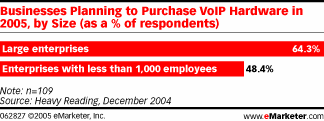
And while the latest survey of CIOs from CIO Magazine and Deutsche Bank reports that just under 50% of CIOs have no plans to install VoIP over the next 12 months (as of October 2004), it finds that roughly 26% will implement the communication technology within the year while under 26% already have VoIP set up.
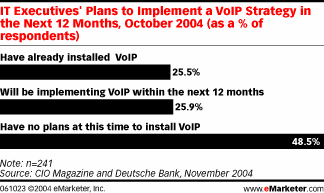
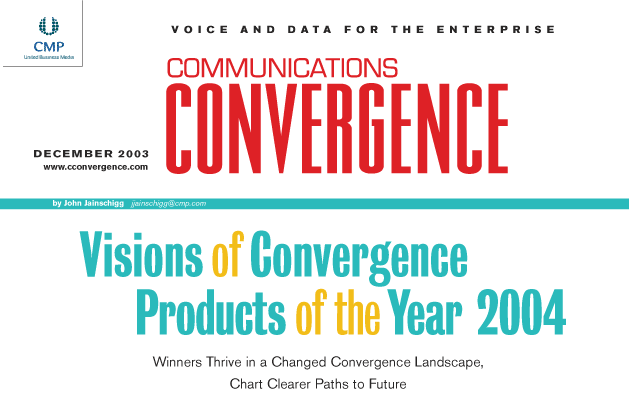
This issue's 2004 Product of the Year Awards attracted submissions from more than 250 vendors. This plethora of entries maps out a convergence landscape much-changed from a year ago, and shows a path to the future that's suddenly clearer in some important respects.
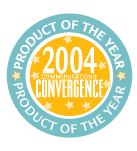 If hype and overprojection were hallmarks of the Internet bubble; under-projection,
and careful treading, have so far governed the recession. For the past few years,
the industry has ordered its PowerPoint presentations towards ROI and legacy-friendliness.
The idea that technology might change the rules entirely was taken off the (public)
table; replaced by a born-again faith that - in telecom at least - change is hard
and takes a long, long time.
If hype and overprojection were hallmarks of the Internet bubble; under-projection,
and careful treading, have so far governed the recession. For the past few years,
the industry has ordered its PowerPoint presentations towards ROI and legacy-friendliness.
The idea that technology might change the rules entirely was taken off the (public)
table; replaced by a born-again faith that - in telecom at least - change is hard
and takes a long, long time.
Meanwhile, technology has changed the rules entirely. Despite the conservative tone of their PPTs, vendors have used the recession to good effect: consolidating new technology initiatives, and turning tentative explorations of ‘optional IP' into core architecture and authoritative product offerings. New market entrants, meanwhile, have had some quiet time to watch the marketplace and lock their offerings to the strongest trends.
Today, lingering economic resistance seems to be encouraging brave moves, rather than retarding them. Our Product of the Year winner's circle is replete with companies who get it - who have moved ahead fast during this era of market quiescence, and are now set to outpace the recovery.
Intermingled amongst our selections, we've invited various industry luminaries to share their "Visions of Convergence" with you in sidebars throughout this article. You'll know they're visionary, of course, by the prerequisite ocular icon. Enjoy. And congrats to this year's winners.
Toshiba's Smart CTX Platforms Centralize Multi-Site Madness
Toshiba America Information Systems (www.toshiba.com) has always been smart about balancing aggressive adoption of new technology and solid core product engineering. Two years ago, they became the first major vendor to OEM a software-based PBX (Artisoft's TeleVantage, marketed as the Toshiba Strata CS Communications Server) subsequently enhancing the product several ways and making it compatible with Toshiba's award-winning digital desksets.
They've also persistently upgraded their now-classic DK line of hybrid PBXs, introducing a new line of integrated, RISC-powered hybrid PBXs (the CTX 100 and 670).
While the exceptionally full-featured CTX series are based around a conventional
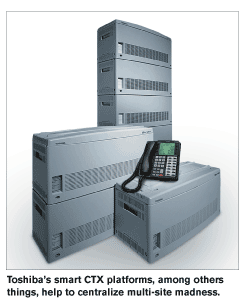 PCM backplane architecture, they can be optioned to access IP trunks and (using
MCK PBX eXtender solutions, which support Toshiba desksets directly at the far end
of an IP voice/signaling link) remote IP stations with full feature support. The
CTX machines sport an extremely robust Q.SIG multi-premise internetworking facility,
as well as Windows-based, IP-linked remote management. Sophisticated ACD software,
UC, and other applications are options.
PCM backplane architecture, they can be optioned to access IP trunks and (using
MCK PBX eXtender solutions, which support Toshiba desksets directly at the far end
of an IP voice/signaling link) remote IP stations with full feature support. The
CTX machines sport an extremely robust Q.SIG multi-premise internetworking facility,
as well as Windows-based, IP-linked remote management. Sophisticated ACD software,
UC, and other applications are options.
The networking of multiple systems has always caught our eye. When centralized, networked systems function as one integrated network that can be configured to let users call each other across nodes with simple directory numbers. This eliminates the need for awkward access codes and network maps. Calls that don't get through can be forwarded to any node in the network, including a centralized voicemail system or attendant.
That's right. One attendant can also serve this entire network. Station users only need to dial "0" to reach the centralized attendant, regardless of the node in which they reside. The attendant can reach any station in the network using its Network Directory Number. Trunks attached to any network node can be programmed to terminate to the centralized attendant.
Unanswered calls are also forwarded to centralized voicemail. The source and calling conditions are identified and the appropriate voice mailbox greeting is played. The voicemail system can control message-waiting indications throughout the network as messages are left and retrieved. A single network can even support multiple centralized voicemail systems, with each station being programmed for the appropriate system.
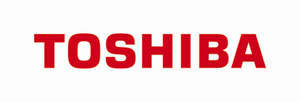
Copyright© 2003 by CMP Media LLC, 600 Community Drive, Manhasset, NY 11030.
Reprinted from COMMUNICATIONS CONVERGENCE with permission.4454
